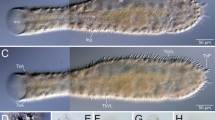Summary
The integument of seven female monogonont and two bdelloid rotifers was studied with the electron microscope.
In the adult animals the area of the wheel-organ is characterized by cellular epidermal thickenings, cilia and microvillus-like structures. On the other hand, in the postcoronal area the epidermis consists of a thin layer of cytoplasm without any plasmamembranes between the nuclei. According to embryological studies this plasma mass constitutes a syncytium.
The “cuticle” of the light microscope is largely an intrasyncytial layer of electrondense material, which is perforated by bulblike invaginations of the surface plasmalemma. These invaginations have been observed in all species investigated and are frequently in close contact with spined vesicles. The intrasyncytial position of the rotifer armour explains the finding that they cannot shed their skin.
The structure of the skin of the spiny-headed wormEchinorhynchus gadi resembles the one of the rotiferBrachionus calyciflorus and is in sharp contrast to that of the cestodes which are also intestinal parasites and do not possess an alimentary canal, too. The similarity of the integument of the two sac-worm groups supports the assumption of their interrelationship.
Zusammenfassung
Das Integument sieben weiblicher monogononter und zwei bdelloider Rotatorien wurde elektronenmikroskopisch untersucht.
Die adulten Tiere sind im Korona-Bereich durch zellige Epidermis-Polster, Zilien und Mikrovilli gekennzeichnet. Im postkoronalen Teil wird die Körperoberfläche von einem zellwandlosen Epithelverband gebildet, der nach den vorliegenden entwicklungsgeschichtlichen Untersuchungen als Synzytium zu bezeichnen ist. Die „Kutikula“ der Lichtmikroskopie stellt zum großen Teil eine intrasynzytiale Verdichtung dar, die von Einsenkungen durchbrochen wird, die allen Arten gleichermaßen zukommen und bisweilen in Kontakt mit Stachelsaumbläschen stehen. Die intrasynzytiale Lage des Rotatorienpanzers erklärt den Befund, daß sich die Rotatorien nicht häuten.
Ähnlich wie das Integument vonBrachionus calyciflorus ist die Haut des AcanthocephalenEchinorhynchus gadi aufgebaut. Damit steht dieser darmlose Endoparasit in scharfem Gegensatz zu den sich ebenfalls parenteral ernährenden Cestoden. Die Ähnlichkeit der beiden Nemathelminthen-Integumente stützt die Annahme einer Verwandtschaft dieser beiden Gruppen.
Similar content being viewed by others
Literatur
Bargmann, W., u.A. Knoop: Elektronenmikroskopische Untersuchungen an Plazentarzotten des Menschen (Bemerkungen zum Synzytiumproblem). Z. Zellforsch.50, 472–493 (1959).
Brakenhoff, H.: Zur Morphologie der Bdelloidea. Zool. Jb.63, Anatomie, 125–182 (1932).
Haffner, K. von: Organisation und systematische Stellung der Acanthocephalen. Zool. Anz.145, Suppl., 243–274 (1950).
Hirschfelder, G.: Beiträge zur Histologie der Rädertiere. Z. wiss. Zool.96, 209–335 (1910).
Koehler, J. K.: A fine-structure study of theRotifer integument. J. Ultrastruct. Res.12, 113–134 (1965).
—: Some comparative fine structure relationships of theRotifer integument. J. exp. Zool.162, 231–243 (1966).
Lehmensick, R.: Zur Biologie, Anatomie und Eireifung der Rädertiere. Z. wiss. Zool.128, 37–113 (1926).
Martini, E.: Studien über die Konstanz histologischer Elemente. III.Hydatina senta. Z. wiss. Zool.102, 425–645 (1912).
Nachtwey, R.: Untersuchungen über die Keimbahn, Organogenese und Anatomie vonAsplanchna priodonta Gosse. Z. wiss. Zool.126, 239–439 (1925).
Pedersen, K, J.: The cellular organization ofConvoluta convoluta, an Acoel Turbellarian: A cytological, histochemical and fine structural study. Z. Zellforsch.64, 655–687 (1964).
Peters, F.: Untersuchungen über Anatomie und Zellkonstanz vonSynchaeta (S. grimpei Remane,S. baltica Ehrenberg,S. tavina Hood undS. triophthalma Lauterborn). Ein Beitrag zur Frage der Artunterschiede bei konstantzelligen Tieren. Z. wiss. Zool.139, 1–119 (1931).
Remane, A.: Rotatoria. In: Bronns Klassen und Ordnungen des Tierreichs, Bd. 4. Leipzig: Akademische Verlagsgesellschaft 1932.
—: Die Grundlagen des natürlichen Systems, der vergleichenden Anatomie und der Phylogenetik. Leipzig: Geest & Portig 1956.
Seehaus, W.: Zur Morphologie der RädertiergattungTestudinella Bory de St. Vincent. Z. wiss. Zool.137, 175–273 (1930).
Author information
Authors and Affiliations
Additional information
Mit dankenswerter Unterstützung durch die Deutsche Forschungsgemeinschaft.
Rights and permissions
About this article
Cite this article
Storch, V., Welsch, U. Über den Aufbau des Rotatorienintegumentes. Z.Zellforsch 95, 405–414 (1969). https://doi.org/10.1007/BF00995213
Received:
Issue Date:
DOI: https://doi.org/10.1007/BF00995213




